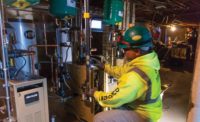'Major' Mass. Gas Leak Follows Feds Call For Regulation Changes One Year After Deadly Gas Explosions
Lawrence Experiences Another Leak on Friday Morning

A natural gas leak in explosive range forced Lawrence, Mass. residents to evacuate their homes early on Sept. 27, according to electric utility National Grid, which cut power to more than 1,300 customers to avoid another disaster like last year's natural gas explosions and fires in Lawrence and two other towns north of Boston. The leak came just days after federal officials called for changes to national pipeline regulations as they released a final report on the causes of the Sept. 13, 2018, disaster.
After the leak was discovered in a high-pressure pipeline at 3:15 a.m. on Sept. 27, hundreds of people were evacuated to a shelter at a local middle school as Columbia Gas of Massachusetts cut gas to 146 customers and searched homes and businesses "door-to-door" for leaked gas, according a Columbia Gas tweet. The Boston Globe reported that the leaking gas line was installed after last year's disaster that killed one person, sent 22 others to the hospital and damaged 131 structures in Lawrence, Andover and North Andover. No fires or explosions had been reported, according to the Massachusetts Emergency Management Agency.
The state determined the gas main was punctured during a routine check in preparation for road paving. Columbia Gas has identified 45 gas valves that the Dept. of Public Utilities has required Columbia Gas and mutual aid partners to inspect immediately. All construction in the area has been suspended until it can be determined that older gas valves have been disabled.
Residents were returning home as inspections on valves were completed. The investigation is ongoing.
Report Findings
Just days earlier During a Sept. 24 hearing in Washington, D.C., the National Transportation Safety Board (NTSB) released its final report on the causes of last year's disaster and issued five new safety recommendations, including calls for revising federal regulations “to require overpressure protection for low pressure natural gas distribution systems that cannot be defeated by a single operator error or equipment failure.”
An erroneously over-pressurized gas line caused last September’s disaster. Furthering its preliminary findings released last September, the NTSB said during the Sept. 24 hearing that Columbia Gas's mistakes made in the years prior to the disaster—along with the omission of a critical sensing lines package for a pipeline replacement project—led to the over-pressurized distribution system. The board said “weak engineering management” resulted in crews abandoning a cast iron main without relocating regulator sensing lines to the new polyethylene main.
The board also called for removing exemptions in 31 states—including Alaska, Arizona, Connecticut, Maine, and New York—so that all future natural gas infrastructure projects require licensed professional engineer approval and stamping. Massachusetts only adopted such a requirement after the disaster. “It’s important to note that in all 50 states you have to have a license to cut hair, “said Bruce Landsberg, NTSB vice chairman, “but you can design a gas system that affects public safety and 31 states exempt you from having a license or even an engineering degree.”
Lori Traweek, the American Gas Association’s chief operating officer, said the association, “continues to learn from this tragic incident and has been focused on understanding exactly what happened in order to continue to improve the safety of the industry and become stronger.”
AGA initiatives to enhance safety include: a report on leading practices to reduce the possibility of a natural gas over-pressurization event, guidance for members on the skills and knowledge necessary to safely perform engineering work functions on a natural gas system and a board of directors resolution recommending that all members implement Pipeline Safety Management Systems.
Traweek said the association is working with the NTSB and other state and local governments “to better understand the cause and help ensure that something like this never happens again.”
Disconnect
The gas fires and explosions in Massachusetts occurred after high-pressure natural gas released into a low-pressure gas distribution system at a Columbia Gas pipe-replacement project in Lawrence—designed and approved by Columbia Gas—without adequate overpressure protection, according to the NTSB.
The board said a Columbia Gas-contracted crew overseen by a Columbia Gas inspector “was working on a tie-in project that bypassed the existing cast-iron line, directing gas pressure to a new plastic line,” minutes before the explosions. The crew left in place the existing cast-iron distribution main that still had its pressure regulator-sensing lines on it. When the old main was disconnected, pressure dropped in the new plastic line, causing the regulators to widen and over-pressurize the system.
NTSB investigators described a “confusing and chaotic” situation in the immediate aftermath of the explosions as crews struggled to locate and shutoff critical valves. "It's amazing to me that a company that operated this system for more than 100 years could not produce a map, a readily made map," said Robert Hall, director of the NTSB’s office of railroad, pipeline and hazardous materials.
A spokesman for Columbia Gas owner NiSource Inc. called NTSB’s investigation “an important step in the effort to enhance pipeline safety” and said it has “taken a series of steps to prevent something similar from happening again,” including installing automatic shut-off devices, accelerating implementation of a Safety Management System, enhancing emergency preparedness and enhanced mapping.
While Columbia Gas has not been fined for the incident to date, it has invested an estimated $250 million in pipeline-replacement expenses, $994 million in third party claims since the Greater Lawrence incident, and $670 million in insurance recoveries, according to Indiana-based NiSource’s second quarter 2019 earnings results published on July 31. Columbia Gas also faces up to $1 million in fines for abandoning gas service lines after the explosions.
An estimated 175,000 residents and business owners affected by the disaster stand to benefit from a $143 million class-action settlement, according to a legal brief filed in the Essex County Superior Court on Sept. 26.
Lawrence mayor Dan Rivera called for the removal of Columbia Gas’s license to distribute gas in Massachusetts.” In a statement, he says the NTSB report indicates “that this could have been avoided and that Columbia Gas failed to implement its own policies as well as industry wide accepted practices.”
On Notice
The fires ignited by gas-fueled appliances and natural gas explosions could’ve easily been avoided two years earlier, according to the NTSB. The board says NiSource first became aware of over-pressurization dangers in 2015 when the company sent a notice to its subsidiaries notifying them about a sensor issue in Kentucky, including a warning that over-pressurized lines, “may lead to a catastrophic event.”
Furthermore, NTSB found that Columbia Gas' initial planning for the Lawrence pipe replacement project in 2015 didn’t address sensing lines. The following year, an Oct. 17 internal email at Columbia Gas noted that the sensing lines would eventually be relocated to the 8-in plastic main. But three constructability reviews conducted by Columbia Gas during the ensuing years still didn’t pick up on the fact that the plans didn’t include the sensing line relocation, according to the NTSB. “Inadequate planning, documentation and recordkeeping processes led to Columbia Gas' omission of the relocation of the sensing lines for the South Union Street Project,” said Sharon Bryson, NTSB managing director.
Robert Sumwalt, NTSB’s chairman added that, “those risks should have been identified and … mitigated … Catastrophic tragedies like this should never happen.”
Sen. Edward Markey (D-Mass.)—who held a hearing on the disaster and also introduced legislation to reform the gas industry with Sen. Elizabeth Warren (D-Mass.) and Rep. Lori Trahan (D-Mass.) in April—said the NTSB plans to discuss their findings during a community meeting in early October in Lawrence. “NiSource’s reckless actions and our loophole-ridden pipeline safety regulations led to death and disaster, with gas pressures reaching between 100 to 150 times higher than they should have been in that system,” Markey said in a statement. “The NTSB final report confirms what Senator Warren and I found during our investigation–that this disaster was not inevitable, it was preventable.”
This story was updated on Oct. 1



